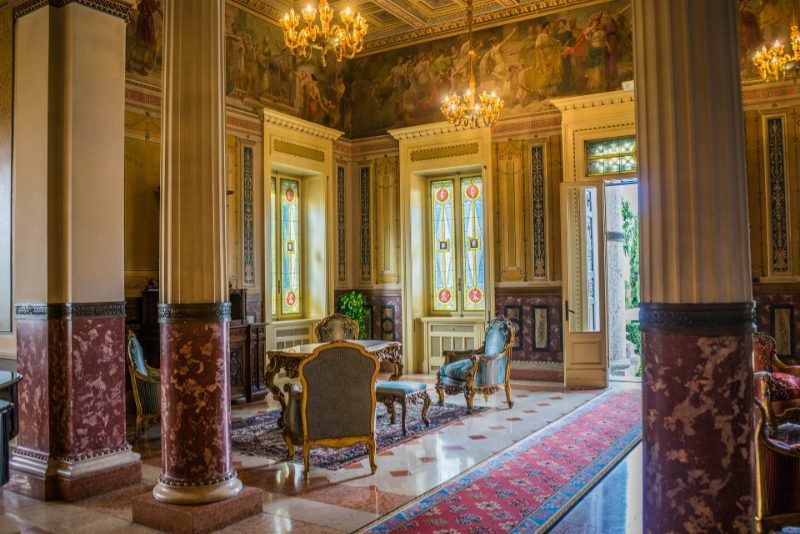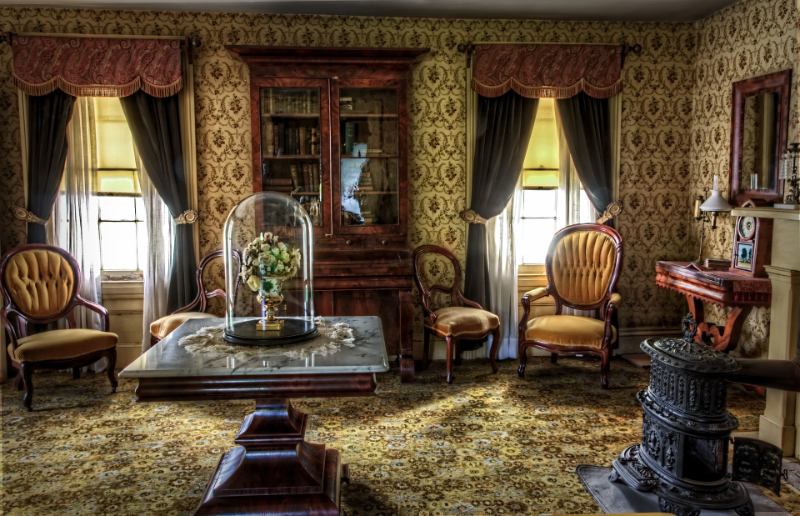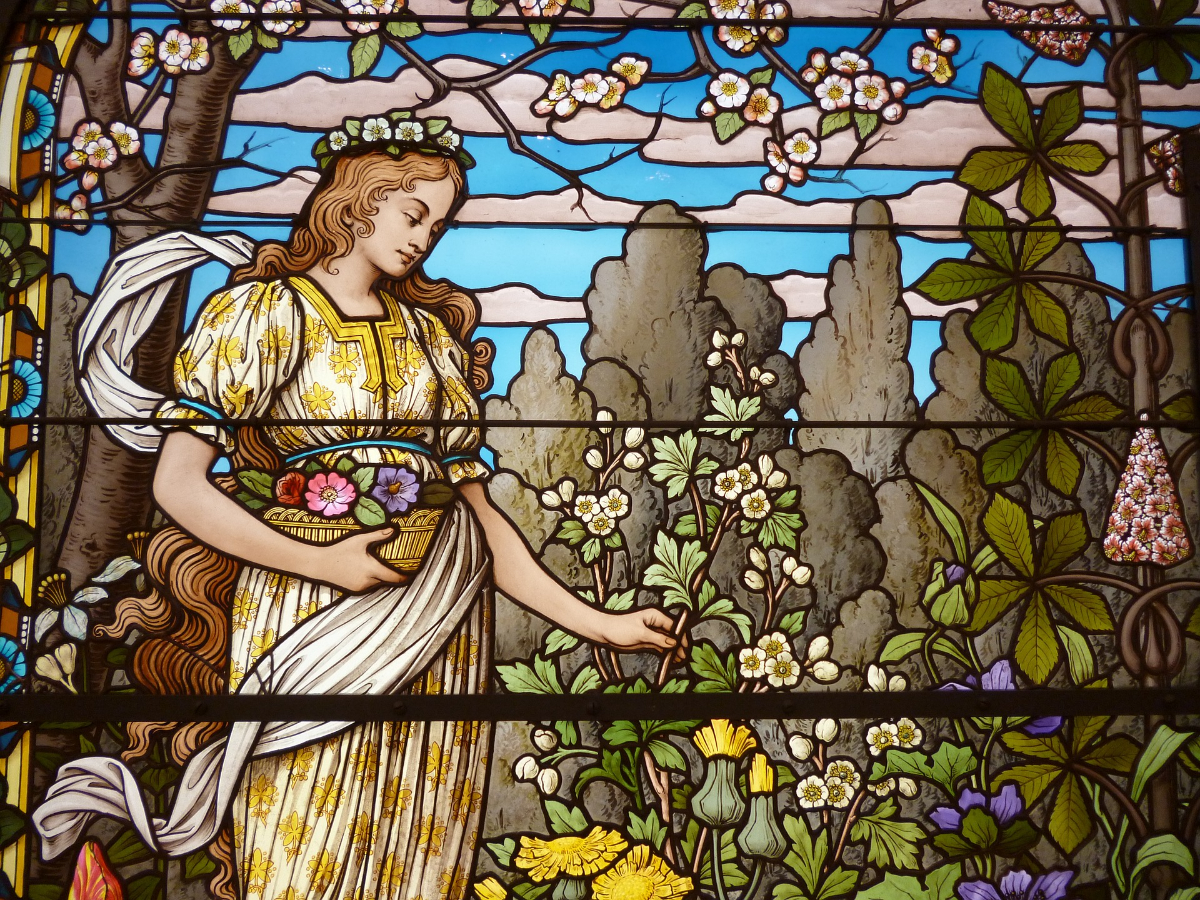This article looks at Victorian era designs and patterns. We look at Victorian-era interior design and ornamental Victorian window glass.
Victorian Style In Refined Society
The Victorian era was influenced by Queen Victoria, who was recognised for her lavish taste, which revolutionised the world of interior design and architecture; the Victorian style was mirrored in relatively cluttered spaces aimed to portray rank, wealth, and romance.
Rich furnishings, patterned wallpapers, colourful tiles, pictorial tapestries, huge houseplants, and chintz dinnerware were used to embellish Victorian interiors. Victorian interiors were a reflection of beauty as well as a display of good manners and social etiquette.
These design techniques were deliberate. Victorians were making social, cultural, and economic statements about the growth of the middle class. The division of space is one characteristic of Victorian interior design.
Victorian homes had as many rooms as they could fit, and each one had a certain function; the home's public and private spaces were distinguished clearly and furnished properly.
Victorian Era Designs & Patterns
Victorian architecture was influenced by numerous sources, including asymmetrical Italianate, straight lines, and angular stick; as technology advanced, machinery-made items became a frequent occurrence in every home, and because they could be purchased by the middle class, they became a style statement.
he Victorian style was influenced by several styles, including Neo-classical, English, French, Gothic, and Italian Renaissance.
Victorian-Era Interior Design:
Prosperity In The Victorian Era
The Victorian era corresponds to Queen Victoria's reign in the United Kingdom and spans around the 1830s to the early 1900s.
The Victorian era followed the Industrial Revolution, and technological improvements continued to allow numerous domestic objects, including decorations, to be mass-produced cheaply throughout the nineteenth and twentieth centuries.
Opulence Among The Middle Class
With furniture, paintings, fabric, and ornamental arts suddenly being affordable to the general public, many middle-class homeowners were able to invest in the décor and design of their homes for the first time.
People crammed their living rooms with lovely objects - wall paintings, curio shelves, and furniture - contributing to the "busy" image that became synonymous with Victorian design, particularly in contrast to modern, minimalistic forms.
The Emergence Of Individual Style
More than just a display of riches, Victorian-era fashion allowed people to express their own interests while also incorporating patterns from Asia, Northern Africa, and other continents.
Victorian interior design became popular because it provided a chance to express one's individuality and allowed for unique design choices.

Kaleidoscope Of Colours & Patterns
The era was marked by vibrant colours created by innovative painting and dying processes. Colours were formerly made using vegetable-based dyes, resulting in subdued, earthy tones.
The Victorian era had vivid colours that people were anxious to utilise in gorgeous plaids, stripes, damask, and flowers in the form of wallpapers, curtains, and upholstery after the development of aniline dyes.
The Queen Anne style
The Queen Anne style, a resurrected type of architecture from the reign of England's Queen Anne, who ruled from 1702 to 1714, was one of the major architectural forms that originated from this era.
The ornate embellishments, corner towers, spacious porches, and patterned walls set the style apart in North America. From early English designs, the style evolved into a range of shapes and regional variants.
Elements Of Victorian Interior Design:
Colours
The deeper tones of the early Victorian period included burgundy, ruby red, forest green, navy blue, and deep brown, whereas the later sections of the century included lighter colours and pastels.
The era is more strongly linked with darker, more subdued hues, which were essential at a time when most homes were heated by coal - darker colours disguised the effects of the smoke and ash.
Furniture
Although no particular furniture design dominated the era, furniture was marked by an abundance of decoration.
Victorian furniture was typically ornately carved and overstuffed, including items such as button-back armchairs, chaise lounges, and ottomans.
Lighting
Light fixtures and candles are essential to this architectural style, especially in places such as dining rooms, living rooms, sitting rooms, and entryways.
Tiffany lamps (with glass lampshades) were a popular period style for not just table or standing lights, but also wall sconces and chandeliers.


Home Decor
In Victorian interior design, accessories and decorations are boldly exhibited and cover every surface.
A gallery wall with framed images exhibiting china, souvenirs, vases, and lace doilies, for example, might be placed on the backs of chairs, tables, or mantels.
Embroidered cushions adorned couches, and potted plants such as palms and ferns were fashionable. Stained glass was another popular technique to bring colour to a place.
Window & Wall Coverings
Heavy fabric drapes and lavish window treatments, such as curtains lined with silk or wool, adorned the windows.
Walls were generally covered in the era's rich, dark paint hues or tapestries or wallpaper with striking flower, leaf, or vine themes. Walls were occasionally painted to resemble marble or wood-grained finishes.
Flooring
Wood, notably parquet patterns, was one of the most popular types of flooring at the time.
Other prevalent floor types were matting, linoleum-like floor cloths, carpeting (including wide weave, Venetian, and reversible), and tiled floors with a repeating geometric design in the centre in the second part of the era.
Ornamental Victorian Window Glass
Etching, enamelling, and wheel cutting the glass created the patterned surface of early architectural glass. Victorian glass manufacturers created elaborate window glass, sometimes known as frosted glass, fancy glass, or veiled glass.
Many historic buildings across the world still contain wonderful examples of these fascinating glass designs, which are produced by etching, painting, or embossing patterns onto hot glass sheets.
The famous method known as "French embossing" or glass etching was created in the middle of the 1800s and is still in use today. When painted onto the surface, paraffin wax (after Brunswick Black) would function as a "resist". The wax layer is then exposed after being stencilled or scraped with a decorative design. A frosted and clear ornamental pattern is quickly etched onto the smooth glass surface by hydrofluoric acid vapour.
You can use physical abrasives, acidic or alkaline solutions, or both to accomplish the same result.A polished plate glass that is 1/4 of an inch thick and has patterns embossed on it is called embossed glass. The design is initially stencilled with Brunswick Black before being embossed.
Fluoric acid is then applied to the surface, which attacks and creates a ground glass surface on the exposed areas; the size of the embossing is customised according to the event. A procedure called mould-etching, in which the pattern was etched straight from the mould was created in the 1920s. The picture was already engraved into the glass surface as each cast piece came out of the mould.
Are you interested in acid etched glass? If you require Victorian Etched Glass Specialist, contact our expert today. We offer professional glass decoration throughout the UK.
